How To Repair Knockdown Texture Ceilings
How to Texture a Ceiling and Walls: Employ Knockdown
Updated: January. 07, 2022
Spray ceiling texture to add visual interest and hide imperfections. Go on reading to learn how to texture a ceiling and walls.
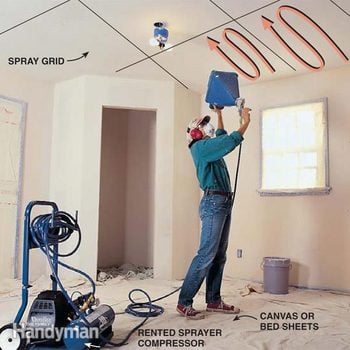
Use this uncomplicated technique to add character to walls and ceilings, and to help blend the old with the new while remodeling. Textures give smoothen, flat walls and ceilings a new dimension that enhances a room. This is a keen project for problem walls as the texture hides minor imperfections.
You lot might also like: TBD
- Time
- Complexity
- Cost
- A full day
- Beginner
- $51–100
Choosing your materials
Textures add an entirely new dimension to apartment, smooth walls. Instead of a blank slate, you'll have a surface that will attract attention, add visual interest and warm the room with an bawdy, organic feel. This technique too helps hibernate minor imperfections, making information technology a nifty way to meld remodeled walls with existing ones—no small bonus to those of us still perfecting our drywall-taping skills!
Applying a knockdown texture is an piece of cake, low-cost, low-tech projection that can dramatically change a room'southward advent and simplify wall repairs. The name comes from one of the final steps in the project when you lot use a wide knife to knock down and flatten the peaks of the texture practical to the walls. This step gives the texture its stucco-like appearance. To texture the walls and ceiling of an boilerplate room, the rental sprayer, the joint compound and knockdown knife will set you dorsum only about $70 to $80, and you'll be finished in one day. These are the three components you'll utilize:
Joint compound
To make this projection as piece of cake as possible, use premixed all-purpose joint chemical compound. These buckets contain about threescore lbs. of "mud" and are available at nigh home centers for $9 to $ten each. Don't use the lightweight premixed compounds—you'll be paying for a lot of air and the mix won't be as "sticky" equally the all-purpose. It generally takes 1-1/2 to two full buckets of mud to texture the walls and ceiling of an average size (12 ten 12-ft.) room.
Knockdown knives
Traditionally, knockdown textures were done with flat trowels or wide steel taping knives. However, the trowel technique is difficult to chief. A much meliorate choice is to apply one of the flexible Lexan knockdown knives now bachelor at drywall supply stores (see Photograph five). These knives are xviii to 24 in. broad and toll $15 to $18.
Acoustical sprayer and gun.
You'll need to hire an acoustical spray gun, hopper and compressor from a rental eye or paint store for this projection. Although dwelling house compressors work fine for the initial orangish peel coat, they won't produce the book of air you demand for the heavier topcoat.
Expect to pay $25 to $30 for a one-mean solar day rental. While you're still at the rental store, be certain to put the machine through a dry run to exist sure it works. Besides, remove the hopper from the gun and make sure the inside of the gun is clean. Look for a trigger adjustment on the gun It allows y'all to command the fluid flow. The recipes in this article will give you lot the just-right mixes for your project.
Tips:
File any precipitous edges off the bract mixer. Sharp edges will scrape little plastic curlicues off the side of the bucket, $.25 that can clog the gun or wind upwards on the wall.
You will become mud in places you didn't desire it. Don't worry! It cleans up easily with a moisture sponge.
CAUTION!
If you lot have ceiling texture applied before 1980, it may contain asbestos. Before you remove any ceiling texture, contact your state'south section of ecology protection, section of health, or a regional asbestos coordinator for information on asbestos testing and removal. For a list of regional contacts, click hither. For full general information on asbestos, click here.
Apply the texture
Photos 1 to 5 evidence how to apply the knockdown texture.
Tip:
Don't let the hopper run dry. Keeping at to the lowest degree four in. of mix in the hopper helps maintain a consequent menstruation.
Tip:
Always make sure y'all start with a clean border on the knockdown pocketknife for each stroke. Keep a damp sponge and a saucepan of water handy for this task.
Dealing with textured ceilings
If you accept acoustical or popcorn ceiling texture, remove it by spraying it with water, letting it soak in for a infinitesimal, and and so advisedly scraping it off with a drywall knife. Habiliment goggles and a cap. To minimize accidental gouging of the drywall, circular off the corners of the pocketknife with metallic snips and remove burrs with a smooth-face file. If your ceiling texture has been painted, you won't exist able to scrape information technology clean. You may need to skim-coat the surface.
Painting a textured surface
Pigment a textured surface the way you would new drywall. Let the "mud" dry completely. Every bit it dries, it volition release tremendous amounts of moisture. Yous'll feel equally if yous're standing in an Iowa cornfield in July. If it's warm enough outside, cut through the masking on your windows and open them, but leave the masking record in place until the surface dries. If you have some box fans, apply them to help speed the drying.
Subsequently the walls and ceiling dry, cheque the surface for any spots you lot missed knocking down or whatever ridges you lot raised with the corner of the knife. With 120-dust sandpaper and a sanding block, sand these high spots downwards. Brainstorm painting with a loftier-quality primer practical with a 3/8-in. nap paint roller. On the first glaze, avoid going over surfaces earlier they're completely dry. The mud is h2o soluble and painting too soon can cause you lot to peel up a sparse layer of mud with the paint.
For the terminal paint glaze, use a high quality latex paint and a 3/8-in. nap roller. An "eggshell" or "satin" finish emphasizes the depth of the texture.
Other Knockdown Textures
If you lot desire to texture merely a small area or a unmarried wall or don't desire to mess with a sprayer, you lot accept an endless supply of options. One of the simplest and most attractive is done with a plastic loop roller or ceiling texture roller, which fits on an ordinary pigment roller. To practise this texture, utilize the same methods equally described in this article except skip the spraying steps and ringlet on a single coat of mud. You tin also apply a knockdown texture using texture paints.
Recipes for Textures
Recipe for orange peel glaze or orange skin ceiling texture:
- Half a saucepan (30 lbs.) of all-purpose articulation compound
- 5 pints of water
- Spray gun orifice—2nd or third smallest
- Compressor setting—high (25 to thirty psi)
- Trigger—half open
- Mix consistency—thin pancake batter
- Splat size—pencil eraser
Recipe for topping coat:
- One-half a bucket (30 lbs.) of all-purpose joint compound
- 3 pints of h2o
- Spray gun orifice—2d largest
- Compressor setting—x to 15 psi
- Trigger—fully open up
- Mix consistency—thick cake concoction
- Splat size—nickel to silvery dollar
Recipe for rolled-on texture:
- Half a saucepan (30 lbs.) of all-purpose joint compound
- 1 pint water
- Mix consistency—thick oatmeal/barely pourable
Required Tools for this Project
Have the necessary tools for this DIY projection lined upwardly before yous start—you'll salve time and frustration.
Mixing paddle, acoustical sprayer and gun (rental), Lexan knockdown pocketknife.
Required Materials for this Projection
Avoid last-infinitesimal shopping trips by having all your materials gear up alee of time. Hither's a list.
Originally Published: Jan 07, 2022
Source: https://www.familyhandyman.com/project/how-to-apply-knockdown-ceiling-texture/
Posted by: hardinchai1986.blogspot.com

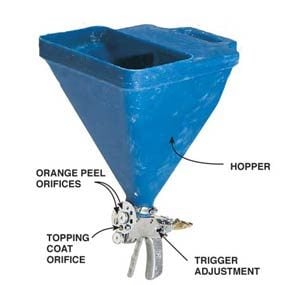
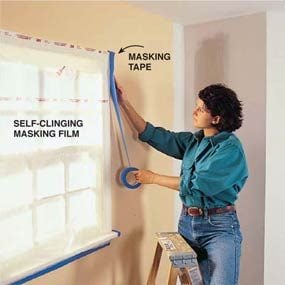
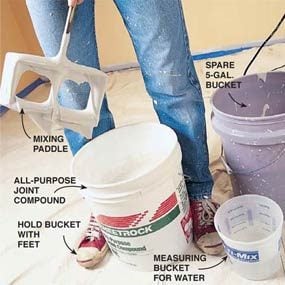
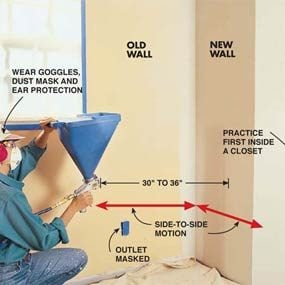
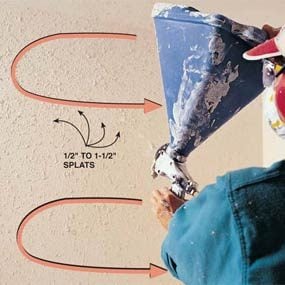
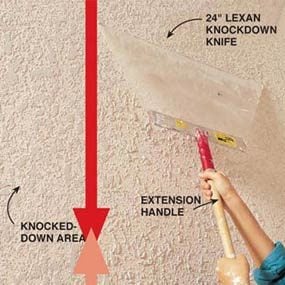
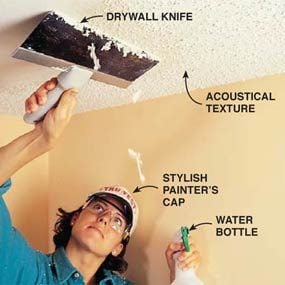

0 Response to "How To Repair Knockdown Texture Ceilings"
Post a Comment